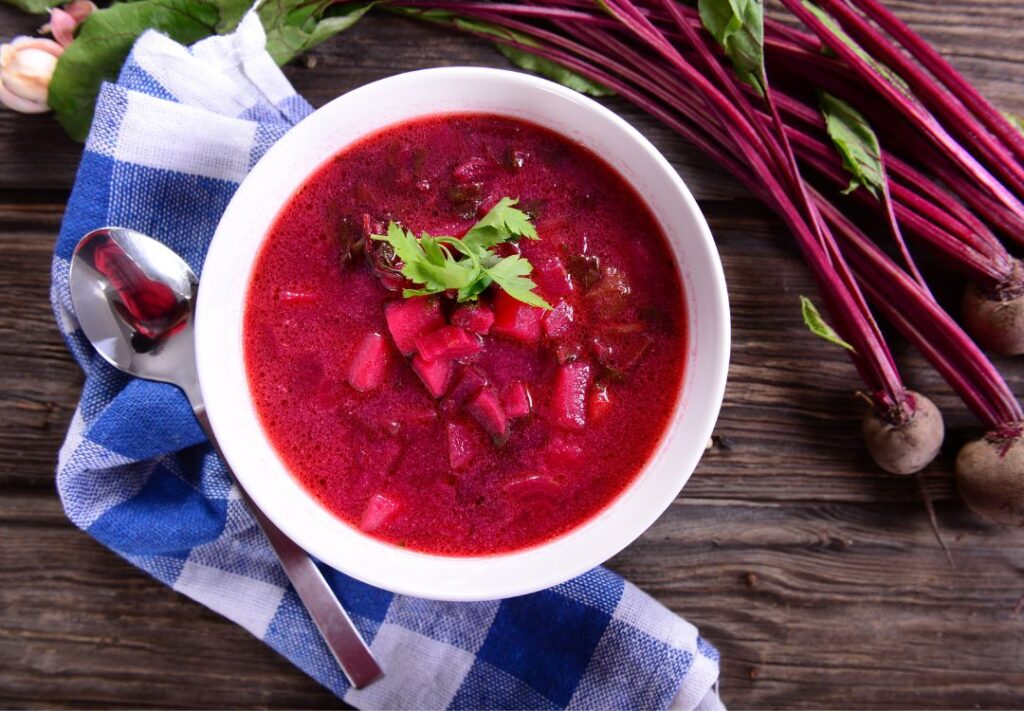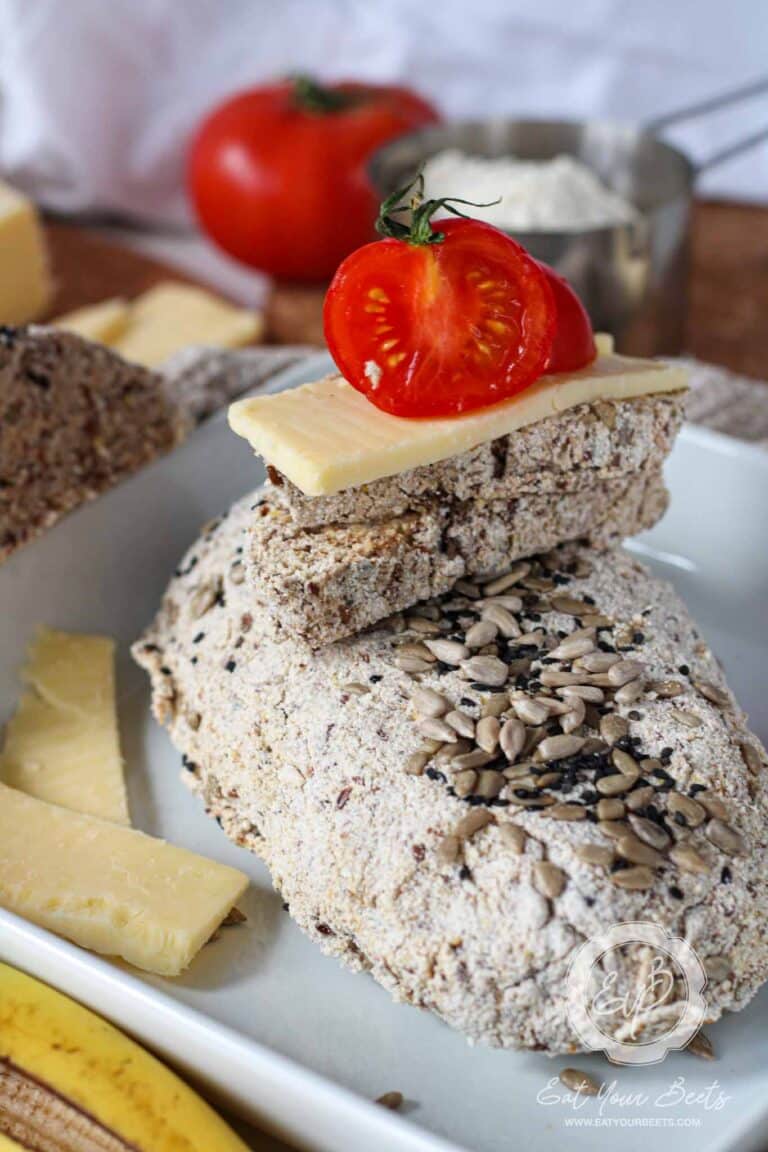Canned Beetroot Vs Fresh (What’s The Difference)
In the culinary world, the debate between canned beetroot vs fresh beetroot is a hot topic. Both variants bring distinct flavors and nutritional profiles to the table, leaving food enthusiasts in a constant quandary.
In this blog post, we aim to put an end to this age-old debate by providing an in-depth comparison of canned beetroot and fresh beetroot. We’ll delve into their nutritional values, taste differences, cooking methods, and more.
Whether you’re a seasoned chef, a health-conscious individual, or simply a beetroot lover looking for some clarity, this comprehensive guide will help you make an informed decision about canned beetroot vs fresh beetroot. Let’s dive in!

Contents
What Are Canned Beets?
Canned beets are a form of preserved beetroots, highly valued for their rich content of vitamins, minerals, and fibers. They are essentially cooked twice during the canning process, once in brine and again after being canned.
Despite being low-calorie, canned beets offer a significant amount of nutrients, with only a few exceptions when compared to fresh beetroots. They are also easy to prepare, often just requiring heating before consumption.
Whether fresh or canned, beets are a good source of nutrients like folate, potassium, and iron, making them a healthy addition to any diet.

What Are Fresh Beets?
Fresh beets, also known as beetroots, are a highly nutritious root vegetable that have been enjoyed since the times of ancient Greece.
Bursting with an array of essential vitamins, minerals, and plant compounds, they have myriad potential benefits that they help reduce the risk of heart disease, improving endurance, and providing powerful antioxidants.
These vibrant red veggies are packed with fiber, manganese, folate, potassium, magnesium, and vitamin C. Beets can be enjoyed in whole, powder, or juice form, offering versatility in your diet.
Not only the roots, but even the leaves of beets are dense with nutrition, making them a full-package, health-boosting food.

Canned Beetroot Vs Fresh: The Key Differences
The debate between canned beetroot and fresh beetroot often comes down to personal preference, convenience, and nutritional value. Here are some key differences between canned beetroot vs fresh beetroot:
Canned Beetroot Vs Fresh: Nutrition
Canned Beetroot
Canned beets are a convenient option for those who want to enjoy this nutritious vegetable without the hassle of peeling and cooking. As part of the canned vegetables family, canned beets retain most of their nutrients, including fiber, potassium, and vitamin C.
However, they often come with a significant amount of added sodium to preserve freshness, which can be a concern for individuals watching their salt intake.
While they may not be as fresh as their raw counterparts, canned beets provide a quick and easy way to add a nutritious boost to your meals.
Fresh Beetroot
Fresh beets, on the other hand, are a powerhouse of nutrition. As fresh vegetables, they contain a higher content of vitamins and minerals than their canned counterparts. They are naturally low in sodium, making them a healthier option for those monitoring their sodium intake.
Fresh beets also offer a crisp texture and robust flavor that is often lost in the canning process. While they require more preparation time, fresh beets are a highly nutritious option that can add a vibrant touch to your culinary creations.
Canned Beetroot Vs Fresh: Affordability
Affordability Of Canned Beetroot
Canned beets offer a budget-friendly alternative for those who want to incorporate this nutritious vegetable into their diet without breaking the bank.
The canned variety is typically less expensive than fresh beets, especially when purchased in bulk or during sales. Additionally, canned beets have a longer shelf life, reducing waste and saving money in the long run.
Affordability Of Fresh Beetroot
On the other hand, fresh beets might cost a bit more, especially if they are organic or locally grown. The price of fresh beets can also fluctuate based on the season and availability. Despite the potentially higher cost, many people prefer the taste and texture of fresh beets.
Canned Beetroot Vs Fresh: Taste
Taste Of Canned Beetroot
Canned beets have a distinct taste that differentiates them from their fresh counterparts. The canning process often includes the addition of vinegar and salt, which can alter the natural earthy sweetness of the beets.
This results in a flavor that’s more tangy and salty than fresh beets. Some people find this taste good and prefer to eat canned beets straight from the can or use them in recipes that call for pickled beets.
Moreover, canned beets are usually cooked during the canning process, giving them a softer texture compared to raw beets.
Taste Of Fresh Beetroot
Fresh beets, on the other hand, offer a robust earthy flavor that many beet lovers find irresistible. They possess an earthy sweetness that is often lost in the canning process.
Fresh ones can be enjoyed raw, roasted, boiled, or juiced, offering a variety of taste experiences. When cooked, they develop a rich, caramelized flavor which pairs well with a plethora of ingredients.
While preparing fresh beets might require more effort, many believe the superior taste and versatility are worth it. Additionally, fresh beet juice is a popular health drink that captures the full flavor profile of this nutritious vegetable.

Canned Beetroot Vs Fresh: Texture
Texture Of Canned Beetroot
Canned beets are typically pre-cooked and often come sliced or diced, which affects their texture. The cooking process makes the beets soft and easy to chew, while the slicing or dicing provides a uniform size for even cooking and easier consumption.
Some canned beets, especially pickled ones, can have a somewhat firm texture due to the pickling process.
However, they generally lack the crispness of fresh beets, and their softness can limit their use in certain recipes that call for a more robust texture.
Texture Of Fresh Beetroot
In contrast, fresh beets offer a range of textures depending on how they’re prepared. Raw beets have a hard, crunchy texture, similar to a carrot, which can add a refreshing crunch to salads.
When cooked, fresh beets become tender yet retain a certain degree of firmness, providing a satisfying bite.
The outer skin of fresh beets also contributes to the overall texture, adding a slight earthy toughness that contrasts nicely with the sweet, soft interior.
From grating raw beets for slaws to roasting them for a caramelized exterior and soft interior, the texture possibilities with fresh beets are virtually endless.

Canned Beetroot Vs Fresh: Cooking Versatility
Cooking Versatility Of Canned Beetroot
Canned beets offer convenience and ease when it comes to cooking. As a pre-cooked and often pre-sliced product, canned beets can be used straight from the can, saving time in preparation and cooking.
They may easily be added to salads, soups, or stews, making them a practical choice for quick meals. However, the texture and taste of canned beets, especially those that have been pickled, may not be suitable for all recipes.
While canned foods like beets offer the advantage of being ready-to-use, their versatility in cooking can be somewhat limited compared to fresh beets.
Cooking Versatility Of Fresh Beetroot
In contrast, fresh beets offer a wide range of cooking possibilities. They can be consumed raw, roasted, boiled, steamed, pickled, or even juiced, allowing them to fit into a variety of dishes.
Whether you’re using them to add a pop of color and earthy sweetness to a salad, or roasting them to bring out their natural sugars, fresh beets are incredibly versatile.
The flexibility of fresh beets allows chefs and home cooks alike to experiment with flavors and techniques, making them a dynamic ingredient in the kitchen.
Despite requiring more preparation time than canned beets, the versatility and depth of flavor that fresh beets bring to a dish often make them worth the extra effort.

Canned Beetroot Vs Fresh: Availability
Availability Of Canned Beetroot
Canned beets are a great option for those who want to eat beets year-round. They are widely available in grocery stores and supermarkets, and their long shelf life means you can stock up and have them on hand whenever you need them.
Canned ones come in several varieties, including sliced beets, whole beets, and pickled beets, providing options to suit different tastes and recipes.
While most canned beets are red beets, some brands may also offer other varieties like golden beets or sugar beets. Their widespread availability and long-lasting nature make canned beets a convenient choice for beet lovers.
Availability Of Fresh Beetroot
Fresh beets, while offering superior taste and texture, may not be as readily available throughout the year. They are a seasonal vegetable, with peak season typically falling in the cooler months.
However, they can often be found at farmers’ markets, health food stores, and some supermarkets during off-peak times. The availability of fresh beets also varies depending on the variety.
Red beets are the most common, but golden beets, sugar beets, and other varieties may be more difficult to find. Despite this, many beet enthusiasts agree that the flavor and versatility of fresh beets are worth seeking out when they’re in season.
Canned Beetroot Vs Fresh: Health Benefits
Health Benefits Of Canned Beetroot
Canned beets, while not as rich in certain nutrients as their fresh counterparts, still offer several health benefits. They are a good source of dietary fiber, that aids in digestion and helps maintaining healthy weight.
Canned beets also contain essential minerals like potassium and iron, as well as vitamins such as vitamin C. However, it’s important to note that the canning process can cause a slight reduction in some of these nutrients compared to fresh beets.
Additionally, canned beets often have added salt for preservation, which could be a consideration for those monitoring their sodium intake.
Health Benefits Of Fresh Beetroot
Fresh beets are renowned for their nutritional benefits. They are packed with vitamins and minerals, including folate, manganese, potassium, iron, and vitamin C. Fresh beets are also high in dietary fiber, which supports digestive health and controls blood sugar levels.
Moreover, they are a great source of phytonutrients like betanin and vulgaxanthin, which have antioxidant and anti-inflammatory properties. As with other vegetables, eating them fresh ensures you get the maximum amount of these nutrients.
While fresh beets require more preparation time than canned ones, their superior nutritional profile makes them a valuable addition to a healthy diet.
Canned Beetroot Vs Fresh: Shelf Life
Canned Beetroot
Canned beets are known for their long shelf life, a common characteristic of canned food. Due to the canning process, which involves heating the beets and sealing them in an airtight can, canned beets can last for several years if unopened and stored properly.
The sodium content acts as a preservative, further extending the shelf life. Once opened, canned beets should be consumed within a few days, similar to other canned vegetables. They should be stored in a refrigerator in a covered non-metallic container after opening.
Fresh Beetroot
Fresh beets, like most fresh food, have a much shorter shelf life. If stored properly in a cool, dark place or in the crisper drawer of your refrigerator, fresh beets can last up to 2-3 weeks.
However, they are best when consumed within a week of purchase to ensure optimal freshness and nutritional value.
Unlike canned beets, fresh beets do not contain added sodium, which means they are less preserved and more prone to spoilage. It’s recommended to check for signs of spoilage such as soft spots or an off smell before consuming.
How To Store Beets? Canned Vs Fresh Beetroot
Storing both canned and fresh beetroot properly can help extend their shelf life and maintain the quality. Here’s how you should store each:
Canned Beetroot:
- Unopened Cans: Store them in a cool, dry place like a pantry. The temperature should ideally be below 85 degrees Fahrenheit (29 degrees Celsius).
- Opened Cans: Once opened, don’t leave the beetroot in the can. Transfer it to an airtight container, cover with the juice from the can (or water), and store it in the refrigerator.
Fresh Beetroot:
- Whole Fresh Beets: Cut off the greens, leaving about one inch of stem on the beet. Store beets using a plastic bag in the crisper drawer of your refrigerator.
- Beet Greens: If the beets came with greens, store them separately using a plastic bag in the refrigerator.
- Cooked Or Peeled Beets: Store in an airtight container in the refrigerator. They should last about a week.
Remember, always check for signs of spoilage before consuming, such as a foul smell, slimy texture, or unusual color change.

So, Which One Is Better? Canned Beetroot Vs Fresh
In conclusion, canned beetroot and fresh beetroot both offer their own advantages and disadvantages. Canned beets are widely available, have a long shelf life, and provide health benefits such as dietary fiber and essential minerals.
Fresh beets are typically more flavorful, have superior nutrition, and can be found during peak season at farmers’ markets or some supermarkets. Ultimately, the decision of whether to choose canned or fresh beets should depend on the user’s individual preference and needs.
However, it is important to store both properly to get the most out of them and reduce spoilage. No matter which you choose, beets can be both flavorful and nutritious addition to your diet.






